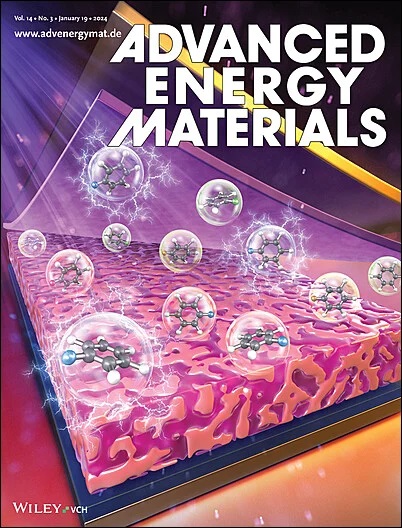Biologically Insoluble Binder for High-Performance Cathodes in Lithium-Ion Batteries
IF 24.4
1区 材料科学
Q1 CHEMISTRY, PHYSICAL
引用次数: 0
Abstract
Binders are vital for maintaining the structural integrity and stability of electrodes in rechargeable batteries. The system of soluble polyvinylidene fluoride in N-methyl-2-pyrrolidone (NMP) is commonly used for commercial cathodes in Li-ion batteries. However, this system has remaining issues, including reliance on the toxic NMP solvent, weak van der Waals bonding, and obnoxious swelling in liquid organic electrolytes, causing difficulty in electrode manufacture and deterioration of mechanical properties during cycles. Herein, inspired by the artificial fishing bait, an eco-friendly and renewable wheat gluten (WG) derived from biomass wheat is utilized as a versatile insoluble binder for battery cathodes. Little water molecules can act as switches for adhesive properties of WG, demonstrating insoluble characteristics, robust hydrogen-bonding capabilities, and a uniform elastic network coating that serves as an effective artificial interphase on cathode materials. Additionally, this binder not only stabilizes the electrolyte by inhibiting and scavenging free radicals but also maintains its rigid mechanical properties in the electrolyte without swelling, resulting in a rather stable microenvironment for active particles, and demonstrating stable cycling performance over 500 cycles of various cathodes such as LiCoO2, LiNi0.5Mn1.5O4, and LiFePO4. This bio-renewable, water-insoluble, and low-cost protein binder offers a promising pathway for advancing high-specific-energy cathode technologies.

高性能锂离子电池阴极的生物不溶性粘结剂
粘合剂对于保持可充电电池中电极的结构完整性和稳定性至关重要。n -甲基-2-吡咯烷酮(NMP)中的可溶性聚偏氟乙烯体系通常用于锂离子电池的商用阴极。然而,该系统仍然存在一些问题,包括依赖有毒的NMP溶剂,范德瓦尔斯键弱,以及液体有机电解质中令人讨厌的肿胀,导致电极制造困难和循环期间机械性能恶化。在这里,受人工鱼饵的启发,从生物质小麦中提取的环保可再生小麦面筋(WG)被用作电池阴极的多功能不溶性粘合剂。小的水分子可以作为WG粘合性能的开关,表现出不溶性,强大的氢键能力,以及作为阴极材料有效人工界面的均匀弹性网络涂层。此外,该粘合剂不仅通过抑制和清除自由基来稳定电解质,而且在电解质中保持其刚性力学性能而不膨胀,从而为活性颗粒提供了相当稳定的微环境,并且在LiCoO2, LiNi0.5Mn1.5O4和LiFePO4等多种阴极的500次循环中表现出稳定的循环性能。这种生物可再生、不水溶性、低成本的蛋白质粘合剂为推进高比能阴极技术提供了一条有前途的途径。
本文章由计算机程序翻译,如有差异,请以英文原文为准。
求助全文
约1分钟内获得全文
求助全文
来源期刊

Advanced Energy Materials
CHEMISTRY, PHYSICAL-ENERGY & FUELS
CiteScore
41.90
自引率
4.00%
发文量
889
审稿时长
1.4 months
期刊介绍:
Established in 2011, Advanced Energy Materials is an international, interdisciplinary, English-language journal that focuses on materials used in energy harvesting, conversion, and storage. It is regarded as a top-quality journal alongside Advanced Materials, Advanced Functional Materials, and Small.
With a 2022 Impact Factor of 27.8, Advanced Energy Materials is considered a prime source for the best energy-related research. The journal covers a wide range of topics in energy-related research, including organic and inorganic photovoltaics, batteries and supercapacitors, fuel cells, hydrogen generation and storage, thermoelectrics, water splitting and photocatalysis, solar fuels and thermosolar power, magnetocalorics, and piezoelectronics.
The readership of Advanced Energy Materials includes materials scientists, chemists, physicists, and engineers in both academia and industry. The journal is indexed in various databases and collections, such as Advanced Technologies & Aerospace Database, FIZ Karlsruhe, INSPEC (IET), Science Citation Index Expanded, Technology Collection, and Web of Science, among others.
 求助内容:
求助内容: 应助结果提醒方式:
应助结果提醒方式:


